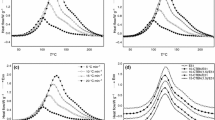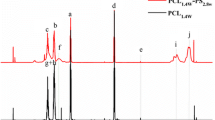Abstract
The effect of a low profile additive, poly(ε-caprolactone) (PCL), on the thermal and mechanical properties of unsaturated polyester resins (UP) was investigated by differential scanning calorimetry (DSC), dynamic mechanical thermal analysis (DMTA), and tensile tests. The morphology of the systems has been studied by scanning electronic microscopy (SEM). Two PCL molecular mass were selected (PCL2: M n = 2000 g mol−1 and PCL50: M n = 50000 g mol−1) to analyze the influence of the molecular mass and the content of PCL on the UP resins and to establish the relation between thermomechanical behavior and morphology. DSC and DMTA glass transition temperatures (T g) of the UP cured samples containing PCL indicate that PCL2 is miscible with UP whereas for UP + PCL50 system, T g values are very close to the ones corresponding to neat UP. Besides in UP + PCL2 systems, one phase morphology is observed in which PCL2 would act as solvent of the reacting mixture along curing process; however, UP + PCL50 systems present phase-separated morphology. The presence of PCL2 and PCL50 in UP resin leads to a decrease of the tensile strength and the Young′s modulus as much notorious as the PCL concentration increases. For UP + PCL2 system the elongation at fracture increases in relation to neat UP, increasing as well with the PCL content.








Similar content being viewed by others
References
Li W, Lee LJ. Shrinkage control of low-profile unsaturated polyester resins cured at low temperature. Polymer. 1998;39:5677–87.
Li W, Lee LJ. Low temperature cure of unsaturated polyester resins with thermoplastic additives: I. Dilatometry and morphology study. Polymer. 2000;41:685–96.
Li W, Lee LJ. Low temperature cure of unsaturated polyester resins with thermoplastic additives. II. Structure formation and shrinkage control mechanism. Polymer. 2000;41:697–710.
Li W, Lee LJ. Low temperature cure of unsaturated polyester resins with thermoplastic additives III. Modification of polyvinyl acetate for better shrinkage control. Polymer. 2000;41:711–7.
Haider M, Hubert P, Lessard L. Cure shrinkage characterization and modeling of a polyester resin containing low profile additives. Composites A. 2007;38:994–1009.
Huang YJ, Cherng Horng J. Effects of thermoplastic additives on mechanical properties and glass transition temperatures for styrene-crosslinked low-shrink polyester matrices. Polymer. 1998;39:3683–95.
Huang YJ, Chen L-D. Effects of chemical composition and structure of unsaturated polyester resins on the miscibility, cured sample morphology and mechanical properties of styrene/unsaturated polyester/low-profile additive ternary systems: 2. Mechanical properties. Polymer. 1998;39:7049–59.
Auad ML, Frontini PM, Borrajo J, Aranguren MI. Liquid rubber modified vinyl ester resins: fracture and mechanical behaviour. Polymer. 2001;42:3723–30.
Engineered materials handbook vol. 2: engineering plastics. ASM International 1988.
Guo Q, Zheng H. Miscibility and crystallization of thermosetting polymer blends of unsaturated polyester resin and poly(ε-caprolactone). Polymer. 1999;40:637–46.
Nava D, Salom C, Prolongo MG, Masegosa RM. Thermal properties and interactions in blends of poly(ε-caprolactone) with unsaturated polyester resins. J Mater Process Technol. 2003;143:171–4.
Masegosa RM, Nava D, Prolongo MG, Salom C. Linear unsaturated polyester+poly(ε-caprolactone) blends: calorimetric behaviour and morphology. Thermochim Acta. 2006;440:93–101.
Salom C, Nava D, Prolongo MG, Masegosa RM. Poly(ε-caprolactone)+unsaturated isophtalic polyester blends: thermal properties and morphology. Eur Polym J. 2006;42:798–1810.
Escribano J, Masegosa R, Nava D, Prolongo MG, Salom C. Kinetic parameters of unsaturated polyester resin modified with poly(ε-caprolactone). J Therm Anal Calorim. 2006;86:675–9.
Worzakowska M. Study of polymerization kinetics of the unsaturated polyester resin using acetyl acetone peroxide and Co (II) octoato. J Therm Anal Calorim. 2007;88:441–8.
Paauw M, Pizzi A. A FT-IR analysis method for simple unsaturated polyesters. J Appl Polym Sci. 1990;42:1377–84.
Delahaye N, Marais S, Saiter JM, Metayer M. Characterization of unsaturated polyester resin cured with styrene. J Appl Polym Sci. 1998;67:695–703.
Grenet J, Marais S, Legras MT, Chevalier P, Saiter JM. DSC and TSDC study of unsaturated polyester resin. Influence of the promoter content. J Therm Anal Calorim. 2000;61:719–30.
Jurkin T, Pucic I. Post-irradiation crosslinking of partially cured unsaturated polyester resin. Rad Phys Chem. 2006;75:1060–8.
Messori M, Toselli M, Pilati F, Tonelli C. Unsaturated polyester resins modified with poly(ε-caprolactone)–perfluoropolyethers block copolymers. Polymer. 2001;42:09855–77.
Jasinska L, Balas A, Haponiuk JT, Nowaczyk G, Jurga S. Thermal and dynamic mechanical analysis of cross-linked poly(esterurethanes). J Therm Anal Calorim. 2007;88:419–23.
Sanchez EMS, Zavaglia CAC, Felisberti MI. Unsaturated polyester resins: influence of the styrene concentration on the miscibility and mechanical properties. Polymer. 2000;41:765–9.
Ferry JD. Viscoelastic properties of polymers. 3rd ed. New York: Wiley; 1980.
Ngai KL, Roland CM. Chemical structure and intermolecular cooperativity: dielectric relaxation results. Macromolecules. 1993;26:6824–30.
Glatz-Reichenbach JK, Sorriero LJ, Fitzgerald F. Influence of crosslinking on the molecular relaxation of an amorphous copolymer near its glass-transition temperature. Macromolecules. 1994;27:1338–43.
Fitz BD, Mijovic J. Molecular dynamics in cyanate ester resin networks and model cyanurate compounds. Macromolecules. 2000;33:887–99.
Berzosa AE, Gómez Ribelles JL, Kripotou S, Pissis P. Relaxation spectrum of polymer networks formed from butyl acrylate and methyl methacrylate monomeric units. Macromolecules. 2004;37:6472–9.
Prolongo MG, Arribas C, Salom C, Masegosa RM. Dynamical mechanical properties and morphology of poly(benzyl methacrylate)/epoxy thermoset blends. Polym Eng Sci. 2010;50:1820–30. doi:10.1002/pen.21707.
Nielsen LE. Cross-linking effect on physical properties of polymers. J Macromol Sci Rev Macromol Chem. 1969;1:69–103.
Vratsano MS, Farris RJ. Network mechanical properties of amine-cured epoxies. Polym Eng Sci. 1989;29:806–16.
De, la Caba K, Guerrero P, Ezeiza A, Mondragon I. Kinetic and rheological studies of an unsaturated polyester cured with different catalyst amounts. Polymer. 1996;37:275–80.
Ramis X, Cadenato A, Morancho JM, Salla JM. Polyurethane-unsaturated polyester interpenetrating polymer networks: thermal and dynamic mechanical thermal behaviour. Polymer. 2001;42:9469–79.
Guo Q, Zheng H, Zheng S, Mi Y, Zhu W. Phase behaviour, mechanical properties and thermal stability of thermosetting polymer blends of unsaturated polyester resin and poly(ethylene oxide). J Mater Sci. 1999;34:123–8.
Acknowledgements
Financial support by MEC (MAT 2006-02123) and CAM (S-0505/MAT0227 Interfases Project) are gratefully acknowledged.
Author information
Authors and Affiliations
Corresponding author
Rights and permissions
About this article
Cite this article
Calvo, S., Escribano, J., Prolongo, M.G. et al. Thermomechanical properties of cured isophtalic polyester resin modified with poly(ε-caprolactone). J Therm Anal Calorim 103, 195–203 (2011). https://doi.org/10.1007/s10973-010-0800-2
Received:
Accepted:
Published:
Issue Date:
DOI: https://doi.org/10.1007/s10973-010-0800-2




